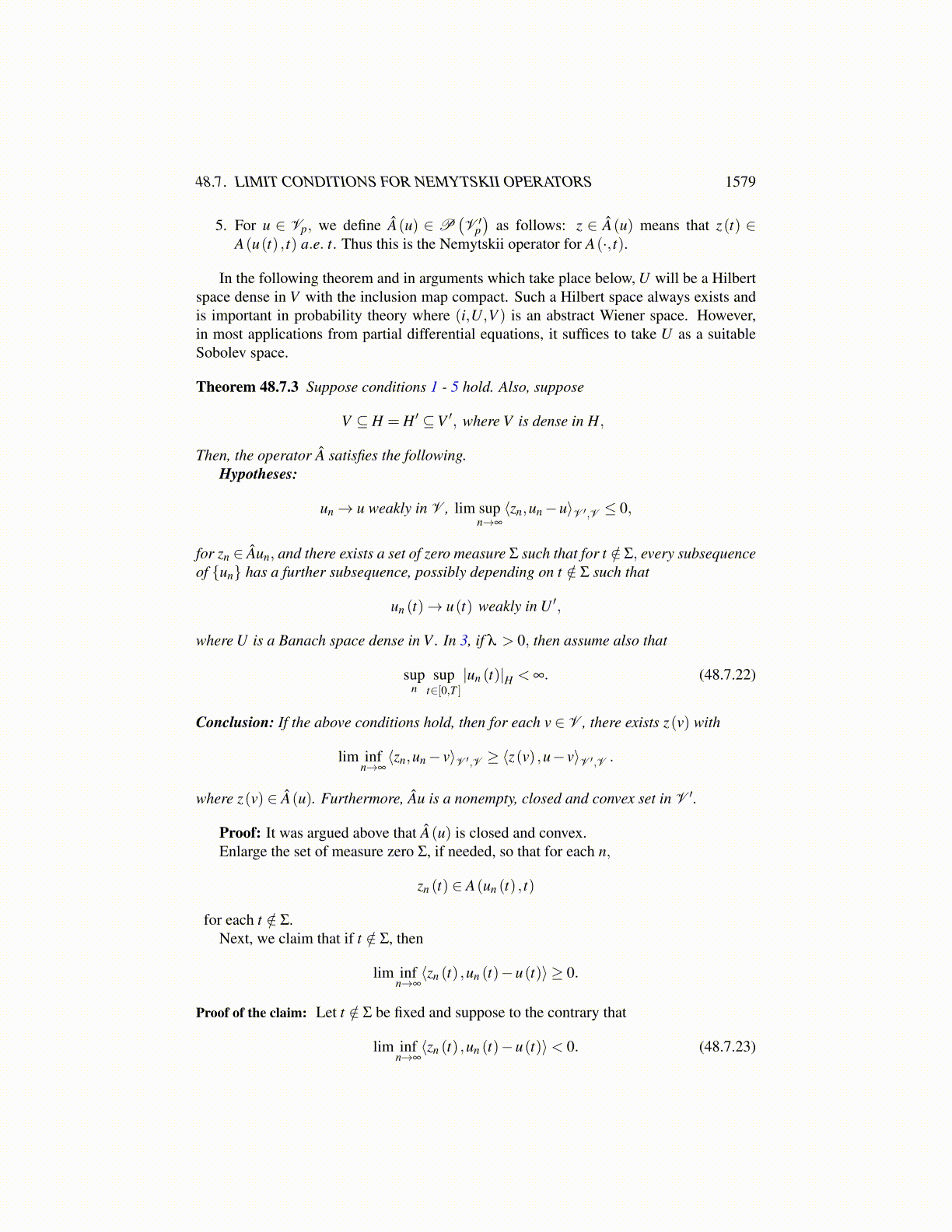
48.7. LIMIT CONDITIONS FOR NEMYTSKII OPERATORS 1579
Let X = ∏∞i=1R with the product topology. Then, this is a Polish space with the metric
defined as d (x,y) = ∑∞i=1
|xi−yi|1+|xi−yi|2
−i. By compactness, for a fixed ω,the h(un (ω)) arecontained in a compact subset of X . Next, define
Γn (ω) = ∪k≥nh(uk (ω)),
which is a nonempty compact subset of X .Next, we claim that ω → Γn (ω) is a measurable multifunction.The proof of the claim is as follows. It is necessary to show that Γ−n (O) defined as
{ω : Γn (ω)∩O ̸= /0} is measurable whenever O is open. It suffices to verify this for O abasic open set in the topology of X . Thus let O = ∏
∞i=1 Oi where each Oi is a proper open
subset of R only for i ∈ { j1, · · · , jm} . Then,
Γ−n (O) = ∪k≥n∩m
r=1{
ω :⟨z jr ,uk (ω)
⟩∈ O jr
},
which is a measurable set since uk is measurable.Then, it follows that ω → Γn (ω) is strongly measurable because it has compact values
in X , thanks to Tychonoff’s theorem. Thus Γ−n (H) = {ω : H ∩Γn (ω) ̸= /0} is measurablewhenever H is a closed set. Now, let Γ(ω) be defined as ∩nΓn (ω) and then for H closed,
Γ− (H) = ∩nΓ
−n (H)
and each set in the intersection is measurable, so this shows that ω→ Γ(ω) is also measur-able. Therefore, it has a measurable selection g(ω). It follows from the definition of Γ(ω)that there exists a subsequence n(ω) such that
g(ω) = limn(ω)→∞
h(un(ω) (ω)
)in X .
In terms of components, we have
gi (ω) = limn(ω)→∞
⟨zi,un(ω) (ω)
⟩.
Furthermore, there is a further subsequence, still denoted with n(ω), such that un(ω) (ω)→u(ω) weakly. This means that for each i,
gi (ω) = limn(ω)→∞
⟨zi,un(ω) (ω)
⟩= ⟨zi,u(ω)⟩ .
Thus, for each zi in a dense set, ω → ⟨zi,u(ω)⟩ is measurable. Since the zi are dense,this implies ω → ⟨z,u(ω)⟩ is measurable for every z ∈ U ′ and so by the Pettis theorem,ω → u(ω) is measurable.
Also is a definition.
Definition 48.7.2 Let A(·, t) : V →P (V ′) . Then, the Nemytskii operator associated withA,
 : Lp ([0,T ] ;V )→P(
Lp′ ([0,T ] ;V ′)) ,is given by
z ∈ Â(u) if and only if z ∈ Lp′ ([0,T ] ;V ′)and z(t) ∈ A(u(t) , t) a.e. t.